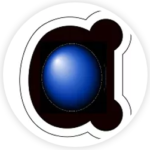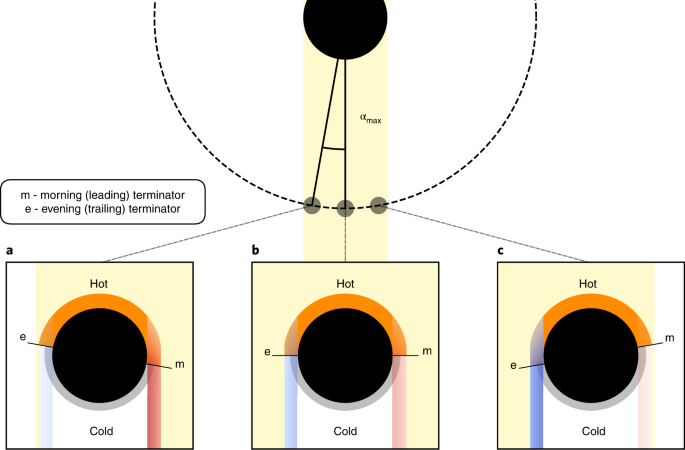Titanium oxide and chemical inhomogeneity in the atmosphere of the exoplanet WASP-189 b
Hubeny, I., Burrows, A. & Sudarsky, D. A possible bifurcation in atmospheres of strongly irradiated stars and planets. Astrophys. J. 594, 1011–1018 (2003).
Fortney, J. J., Lodders, K., Marley, M. S. & Freedman, R. S. A unified theory for the atmospheres of the hot and very hot Jupiters: two classes of irradiated atmospheres. Astrophys. J. 678, 1419 (2008).
Désert, J. M. et al. Atmospheric composition and structure of HD 209458b (eds Pont, F. et al.) in Proc. IAU Symp., 524–527 (Cambridge Univ. Press, 2009).
Sedaghati, E. et al. Detection of titanium oxide in the atmosphere of a hot Jupiter. Nature 549, 238–241 (2017).
Evans, T. M. et al. An ultrahot gas-giant exoplanet with a stratosphere. Nature 548, 58–61 (2017).
Evans, T. M. et al. An optical transmission spectrum for the ultrahot Jupiter WASP-121b measured with the Hubble Space Telescope. Astron. J. 156, 283 (2018).
Nugroho, S. K. et al. High-resolution spectroscopic detection of TiO and a stratosphere in the day-side of WASP-33b. Astron. J. 154, 221 (2017).
Hoeijmakers, H. et al. A search for TiO in the optical high-resolution transmission spectrum of HD 209458b: hindrance due to inaccuracies in the line database. Astron. Astrophys. 575, A20 (2015).
Espinoza, N. et al. ACCESS: a featureless optical transmission spectrum for WASP-19b from Magellan/IMACS. Mon. Not. R. Astron. Soc. 482, 2065–2087 (2019).
Sedaghati, E. et al. A spectral survey of WASP-19b with ESPRESSO. Mon. Not. R. Astro. Soc. 505, 435–458 (2021).
Merritt, S. R. et al. Non-detection of TiO and VO in the atmosphere of WASP-121b using high-resolution spectroscopy. Astron. Astrophys. 636, A117 (2020).
Herman, M. K., de Mooij, E. J., Jayawardhana, R. & Brogi, M. Search for TiO and optical nightside emission from the exoplanet WASP-33b. Astron. J. 160, 93 (2020).
Serindag, D. B. et al. Is TiO emission present in the ultrahot Jupiter WASP-33b? A reassessment using the improved ExoMol Toto line list. Astron. Astrophys. 645, A90 (2021).
Anderson, D. et al. WASP-189b: an ultrahot Jupiter transiting the bright A star HR 5599 in a polar orbit. Preprint at https://arxiv.org/abs/1809.04897 (2018).
Snellen, I. A. G., de Kok, R. J., de Mooij, E. J. W. & Albrecht, S. The orbital motion, absolute mass and high-altitude winds of exoplanet HD209458b. Nature 465, 1049–1051 (2010).
Lendl, M. et al. The hot dayside and asymmetric transit of WASP-189 b seen by CHEOPS. Astron. Astrophys. 643, A94 (2020).
Hoeijmakers, H. J. et al. Atomic iron and titanium in the atmosphere of the exoplanet KELT-9b. Nature 560, 453–455 (2018).
Casasayas-Barris, N. et al. Na i and Hα absorption features in the atmosphere of MASCARA-2b/KELT-20b. Astron. Astrophys. 616, A151 (2018).
Hoeijmakers, H. J. et al. A spectral survey of an ultrahot Jupiter—detection of metals in the transmission spectrum of KELT-9 b. Astron. Astrophys. 627, A165 (2019).
Casasayas-Barris, N. et al. Atmospheric characterization of the ultrahot Jupiter MASCARA-2b/KELT-20b—detection of Ca ii, Fe ii, Na i, and the Balmer series of H (Hα, Hβ, and Hγ) with high-dispersion transit spectroscopy. Astron. Astrophys. 628, A9 (2019).
Cauley, P. W. et al. Atmospheric dynamics and the variable transit of KELT-9 b. Astron. J. 157, 69 (2019).
Ehrenreich, D. et al. Nightside condensation of iron in an ultrahot giant exoplanet. Nature 580, 597–601 (2020).
Gibson, N. P. et al. Detection of Fe i in the atmosphere of the ultrahot Jupiter WASP-121b, and a new likelihood-based approach for Doppler-resolved spectroscopy. Mon. Not. R. Astron. Soc. 493, 2215–2228 (2020).
Hoeijmakers, H. J. et al. High-resolution transmission spectroscopy of MASCARA-2 b with EXPRES. Astron. Astrophys. 641, A120 (2020).
Hoeijmakers, H. J. et al. Hot Exoplanet Atmospheres Resolved with Transit Spectroscopy (HEARTS)—IV. A spectral inventory of atoms and molecules in the high-resolution transmission spectrum of WASP-121 b. Astron. Astrophys. 641, A123 (2020).
Nugroho, S. K. et al. Searching for thermal inversion agents in the transmission spectrum of KELT-20b/MASCARA-2b: detection of neutral iron and ionised calcium H&K lines. Mon. Not. R. Astron. Soc. 496, 504–522 (2020).
Nugroho, S. K. et al. Detection of Fe i emission in the dayside spectrum of WASP-33b. Astrophys. J. Lett. 898, L31 (2020).
Pino, L. et al. Neutral iron emission lines from the dayside of KELT-9b: the GAPS program with HARPS-N at TNG XX. Astrophys. J. Lett. 894, L27 (2020).
Stangret, M. et al. Detection of Fe i and Fe ii in the atmosphere of MASCARA-2b using a cross-correlation method. Astron. Astrophys. 638, A26 (2020).
Yan, F. et al. A temperature inversion with atomic iron in the ultrahot dayside atmosphere of WASP-189b. Astron. Astrophys. 640, L5 (2020).
Borsa, F. et al. Atmospheric Rossiter–McLaughlin effect and transmission spectroscopy of WASP-121b with ESPRESSO. Astron. Astrophys. 645, A24 (2021).
Tabernero, H. M. et al. ESPRESSO high-resolution transmission spectroscopy of WASP-76 b. Astron. Astrophys. 646, A158 (2021).
Smette, A. et al. Molecfit: a general tool for telluric absorption correction—I. Method and application to ESO instruments. Astron. Astrophys. 576, A77 (2015).
Kausch, W. et al. Molecfit: a general tool for telluric absorption correction—II. Quantitative evaluation on ESO-VLT/X-Shooter spectra. Astron. Astrophys. 576, A78 (2015).
Seager, S. & Sasselov, D. D. Theoretical transmission spectra during extrasolar giant planet transits. Astrophys. J. 537, 916–921 (2000).
Brogi, M. et al. The signature of orbital motion from the dayside of the planet τ Boötis b. Nature 486, 502–504 (2012).
Showman, A. P., Fortney, J. J., Lewis, N. K. & Shabram, M. Doppler signatures of the atmospheric circulation on hot Jupiters. Astrophys. J. 762, 24 (2013).
Kempton, E. M. R., Perna, R. & Heng, K. High resolution transmission spectroscopy as a diagnostic for Jovian exoplanet atmospheres: constraints from theoretical models. Astrophys. J. 795, 24 (2014).
Louden, T. & Wheatley, P. J. Spatially resolved eastward winds and rotation of HD 189733b. Astrophys. J. Lett. 814, L24 (2015).
Brogi, M. et al. Rotation and winds of exoplanet HD 189733 b measured with high-dispersion transmission spectroscopy. Astrophys. J. 817, 106 (2016).
Fortney, J. J., Cooper, C. S., Showman, A. P., Marley, M. S. & Freedman, R. S. The influence of atmospheric dynamics on the infrared spectra and light curves of hot Jupiters. Astrophys. J. 652, 746–757 (2006).
Spiegel, D. S., Silverio, K. & Burrows, A. Can TiO explain thermal inversions in the upper atmospheres of irradiated giant planets? Astrophys. J. 699, 1487–1500 (2009).
Stevenson, K. B. et al. Thermal structure of an exoplanet atmosphere from phase-resolved emission spectroscopy. Science 346, 838–841 (2014).
Showman, A. P., Lewis, N. K. & Fortney, J. J. 3D atmospheric circulation of warm and hot Jupiters. Astrophys. J. 801, 95 (2015).
Parmentier, V. et al. From thermal dissociation to condensation in the atmospheres of ultra hot Jupiters: WASP-121b in context. Astron. Astrophys. 617, A110 (2018).
Pluriel, W., Zingales, T., Leconte, J. & Parmentier, V. Strong biases in retrieved atmospheric composition caused by day–night chemical heterogeneities. Astron. Astrophys. 636, A66 (2020).
Wardenier, J. P., Parmentier, V., Lee, E. K. H., Line, M. & Gharib-Nezhad, E. Decomposing the iron cross-correlation signal of the ultra-hot Jupiter WASP-76b in transmission using 3D Monte-Carlo radiative transfer. Mon. Not. R. Astron. Soc. 506, 1258–1283 (2021).
Fossati, L. et al. A data-driven approach to constraining the atmospheric temperature structure of the ultrahot Jupiter KELT-9b. Astron. Astrophys. 643, A131 (2020).
Lothringer, J. D., Fu, G., Sing, D. K. & Barman, T. S. UV exoplanet transmission spectral features as probes of metals and rainout. Astrophys. J. Lett. 898, L14 (2020).
Bourrier, V. et al. Hot Exoplanet Atmospheres Resolved with Transit Spectroscopy (HEARTS)—III. Atmospheric structure of the misaligned ultrahot Jupiter WASP-121b. Astron. Astrophys. 635, A205 (2020).
Lodders, K. Solar system abundances and condensation temperatures of the elements. Astrophys. J. 591, 1220–1247 (2003).
Mendonça, J. M., Tsai, S.-M., Malik, M., Grimm, S. L. & Heng, K. Three-dimensional circulation driving chemical disequilibrium in WASP-43b. Astrophys. J. 869, 107 (2018).
Ahlers, J. P. et al. KELT-9 b’s asymmetric TESS transit caused by rapid stellar rotation and spin–orbit misalignment. Astron. J. 160, 4 (2020).
Changeat, Q. & Edwards, B. The Hubble WFC3 emission spectrum of the extremely hot Jupiter KELT-9b. Astrophys. J. Lett. 907, L22 (2021).
Chen, G., Palle, E., Parviainen, H., Murgas, F. & Yan, F. Evidence for TiO in the atmosphere of the hot Jupiter HAT-P-65 b. Astrophys. J. Lett. 913, 14 (2021).
Astropy Collaboration et al. Astropy: a community Python package for astronomy. Astron. Astrophys. 558, A33 (2013).
Astropy Collaboration et al. The Astropy Project: building an open-science project and status of the v2.0 core package. Astron. J. 156, 123 (2018).
Lendl, M. et al. WASP-42 b and WASP-49 b: two new transiting sub-Jupiters. Astron. Astrophys. 544, A72 (2012).
Mandel, K. & Agol, E. Analytic light curves for planetary transit searches. Astrophys. J. Lett. 580, L171–L175 (2002).
Lendl, M. et al. TOI-222: a single-transit TESS candidate revealed to be a 34-d eclipsing binary with CORALIE, EulerCam, and NGTS. Mon. Not. R. Astron. Soc. 492, 1761–1769 (2020).
McKemmish, L. K. et al. ExoMol molecular line lists—XXXIII. The spectrum of titanium oxide. Mon. Not. R. Astron. Soc. 488, 2836–2854 (2019).
Gaudi, B. S. et al. A giant planet undergoing extreme-ultraviolet irradiation by its hot massive-star host. Nature 546, 514–518 (2017).
Cegla, H. M. et al. Modeling the Rossiter–McLaughlin effect: impact of the convective center-to-limb variations in the stellar photosphere. Astrophys. J. 819, 67 (2016).
Stock, J. W., Kitzmann, D., Patzer, A. B. C. & Sedlmayr, E. FastChem: a computer program for efficient complex chemical equilibrium calculations in the neutral/ionized gas phase with applications to stellar and planetary atmospheres. Mon. Not. R. Astron. Soc. 479, 865–874 (2018).
Gaidos, E., Kitzmann, D. & Heng, K. Exoplanet characterization by multi-observatory transit photometry with TESS and CHEOPS. Mon. Not. R. Astron. Soc. 468, 3418–3427 (2017).
Grimm, S. L. & Heng, K. HELIOS-K: an ultrafast, open-source opacity calculator for radiative transfer. Astrophys. J. 808, 182 (2015).
Grimm, S. L. et al. HELIOS-K 2.0 opacity calculator and open-source opacity database for exoplanetary atmospheres. Astrophys. J. Suppl. Ser. 253, 30 (2021).
Li, G. et al. Rovibrational line lists for nine isotopologues of the CO molecule in the X 1Σ+ ground electronic state. Astrophys. J. Suppl. Ser. 216, 15 (2015).
Ryabchikova, T. et al. A major upgrade of the VALD database. Phys. Scr. 90, 054005 (2015).
Tennyson, J. et al. The ExoMol database: molecular line lists for exoplanet and other hot atmospheres. J. Mol. Spectrosc. 327, 73–94 (2016).
Polyansky, O. L. et al. ExoMol molecular line lists XXX: a complete high-accuracy line list for water. Mon. Not. R. Astron. Soc. 480, 2597–2608 (2018).
Valenti, J. A. & Piskunov, N. Spectroscopy Made Easy: a new tool for fitting observations with synthetic spectra. Astron. Astrophys. Suppl. 118, 595–603 (1996).
Piskunov, N. & Valenti, J. A. Spectroscopy made easy: evolution. Astron. Astrophys. 597, A16 (2017).
Gustafsson, B. et al. A grid of MARCS model atmospheres for late-type stars. I. Methods and general properties. Astron. Astrophys. 486, 951–970 (2008).
Seidel, J. et al. Hot Exoplanet Atmospheres Resolved with Transit Spectroscopy (HEARTS)—II. A broadened sodium feature on the ultrahot giant WASP-76b. Astron. Astrophys. 623, A166 (2019).
Seidel, J. V. et al. Wind of change: retrieving exoplanet atmospheric winds from high-resolution spectroscopy. Astron. Astrophys. 633, A86 (2020).
Redfield, S., Endl, M., Cochran, W. D. & Koesterke, L. Sodium absorption from the exoplanetary atmosphere of HD 189733b detected in the optical transmission spectrum. Astrophys. J. Lett. 673, L87 (2008).
Seidel, J. V. et al. Hot Exoplanet Atmospheres Resolved with Transit Spectroscopy (HEARTS)—VI. Non-detection of sodium with HARPS on the bloated super-Neptune WASP-127b. Astron. Astrophys. 643, A45 (2020).
Try Adsterra Earnings, it’s 100% Authentic to make money more and more.

More Story on Source:
*here*
Titanium oxide and chemical inhomogeneity in the atmosphere of the exoplanet WASP-189 b
Published By

Latest entries
 allPost2025.01.31Husband of Potomac crash victim says he had dinner waiting at home for her
allPost2025.01.31Husband of Potomac crash victim says he had dinner waiting at home for her allPost2025.01.31NTSB: Divers have searched ‘all accessible areas’ of the Potomac River
allPost2025.01.31NTSB: Divers have searched ‘all accessible areas’ of the Potomac River allPost2025.01.316-year-old Sama al-Qudra was ‘the last child killed’ before the Gaza ceasefire
allPost2025.01.316-year-old Sama al-Qudra was ‘the last child killed’ before the Gaza ceasefire allPost2025.01.31Топ онлайн казино россии 2025 рейтинг и обзор платформ
allPost2025.01.31Топ онлайн казино россии 2025 рейтинг и обзор платформ



